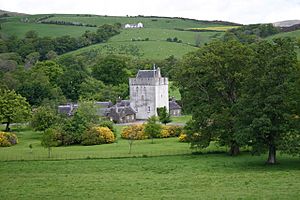Kames Castle facts for kids
Kames Castle is an old building found on the beautiful Isle of Bute in Scotland. It sits right by Kames Bay, close to a village called Port Bannatyne. The castle has a tall tower house that was built a long time ago, in the 1500s. Later, some smaller cottages were added to it.
The castle is surrounded by a big garden, about 20 acres (81,000 m2) in size. This includes a special walled garden from the 1700s, which is about 2-acre (8,100 m2) big.
History of Kames Castle
The land where Kames Castle stands was given to the Bannatyne family. This happened in the 1300s, by a famous Scottish king named Robert the Bruce. Even though the castle looks like it's from the 1300s, the tower house you see today was probably built in the 1500s.
The last owner from the Bannatyne family was Sir William Macleod Bannatyne. He was a very important lawyer and judge in Edinburgh. In 1799, he became a judge in a high court called the College of Justice. In the late 1700s and early 1800s, he created the walled garden and built a large house next to the tower.
Kames Castle was also the birthplace of a writer named John Sterling. He lived there when he was young. Another famous writer, Thomas Carlyle, described the castle as an "old castle-like home" that had a small farm attached to it.
Around 1810, Lord Bannatyne sold the estate. He preferred living in Edinburgh. In 1863, Kames Castle became part of the land owned by the Marquess of Bute. The tower house was changed a bit in the late 1800s. Around 1900, the large house that Lord Bannatyne built was taken down. In its place, several cottages were built around a courtyard. The idea was to make it a place for hunting trips.
In the middle to late 1900s, Kames Castle was used as a holiday home for children. It was run by a group called the Scottish Council for Spastics. Today, the castle is owned by a private family. Some of the cottages are available for people to rent for holidays. The castle, its cottages, the walled garden, and other buildings on the estate are all protected as important historic buildings.



